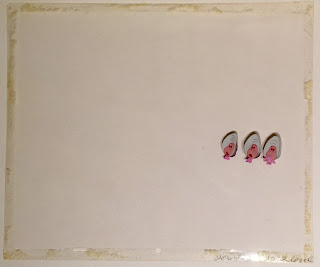Four original hand inked and hand painted production cels of The Walrus, Oysters (row of fronts and row of backs), and menu set on a hand prepared watercolor non-production background from "Alice In Wonderland," 1951; Production numbers bottom right on all four cels 1) The Walrus with menu 2) 6 oyster backs 3) table menu 4) 3 oyster fronts; Size - The Walrus & Oysters 9 1/2" x 10", Cels 11 1/2" x 13 3/4"; Image 10 1/2" x 13"; Unframed.
"Alice's Adventures in Wonderland" (commonly shortened to "Alice in Wonderland"), is a 1865 novel written by English author Charles Lutwidge Dodgson who wrote under the pseudonym Lewis Carroll. Disney reworked the story to fit with both a younger audience and a time frame suitable for an animated film (it's run time is only 75 minutes).
Photograph showing the four cels on the hand prepared watercolor background.
One of the most memorable segments of "Alice In Wonderland" were the two characters The Walrus and The Carpenter. Both of them were voiced by J. Pat O'Malley and they were animated by John Lounsbery, Ward Kimball, Wolfgang Reitherman, and Charles A. Nichols. They were originally created by Lewis Carroll for his book "Through the Looking Glass."
J. Pat O'Malley had a long history with voice work for Disney: he was the Cockney guy in the "Supercalifragilisticexpialidocious" sequence in "Mary Poppins," 1964, Cyril Proudbottom, Winkie, and a policeman in "The Adventures of Ichabod and Mr. Toad," 1949, and Colonel Hathi and Buzzie in "The Jungle Book," 1967. O'Malley performs all the character voices in the "The Walrus and the Carpenter" segment (besides Alice), including Tweedledum and Tweedledee, The Walrus, The Carpenter, and Mother Oyster.
Walrus cel with close up of the production numbers.
Oyster backs cel with close up of the production numbers.
Menu cel with close up of the production numbers.
Oyster fronts cel with close up of the production numbers.
The Walrus and The Carpenter are two hobos whose story was told to Alice by Tweedle Dee and Tweedle Dum. The Walrus acts as the leader of the duo and in many ways he is like Honest John from "Pinocchio." They are both conniving moochers who will resort to trickery to get what they want. Finding a job and working is the last thing on The Walrus's mind, regardless of his constant ramblings of "cabbages and kings" (his way of saying that his future will soon be bright). He is also very greedy and tricks The Carpenter into leave the room so that he can eat all of the naive oysters (whom he had convinced to follow him ashore and into a restaurant that The Carpenter built out of left over remnants from a boat).
This is a wonderful four cel setup including: a cel of The Walrus, a cel of three oysters facing front, a cel of six oysters whose backs are facing, and an additional cel of the table menu. The menu cel was used as a hold cel until the menu was picked up by The Walrus. These cels are from the scene that occurs just as The Carpenter, ready to start eating dinner, sits down at the table across from The Walrus. The Walrus asked The Carpenter for a loaf of bread (in order to get rid of The Carpenter) so that he would be all alone to devour the oysters by himself! The dialog for the scene is below:
The Walrus: "A loaf of bread is what we chiefly need!"
The Carpenter: "Listen, how 'bout some pepper and salt and vinegar, eh?"
The Walrus: "Well, yes, yes, splendid idea, ha ha! Very good, indeed."
To view the scene which this cel was used to create, click on the short video below:
#Alice #madhatter #Walrus #WalrusandCarpenter #Oysters #JPatOMalley #aliceinwonderland #marchhare #KathrynBeaumont #HyndenWalch #OllieJohnston #MarcDavis #teaparty #unbirthday #disney #WaltDisney #LesClark #MaryBlair #untitledartgallery #animation #productioncel #animationart #lewiscarroll #edwynn #jerrycolonna #cel #animationcel #artcollecting #JohnLounsbery #WardKimball #WolfgangReitherman #CharlesNichols










No comments:
Post a Comment